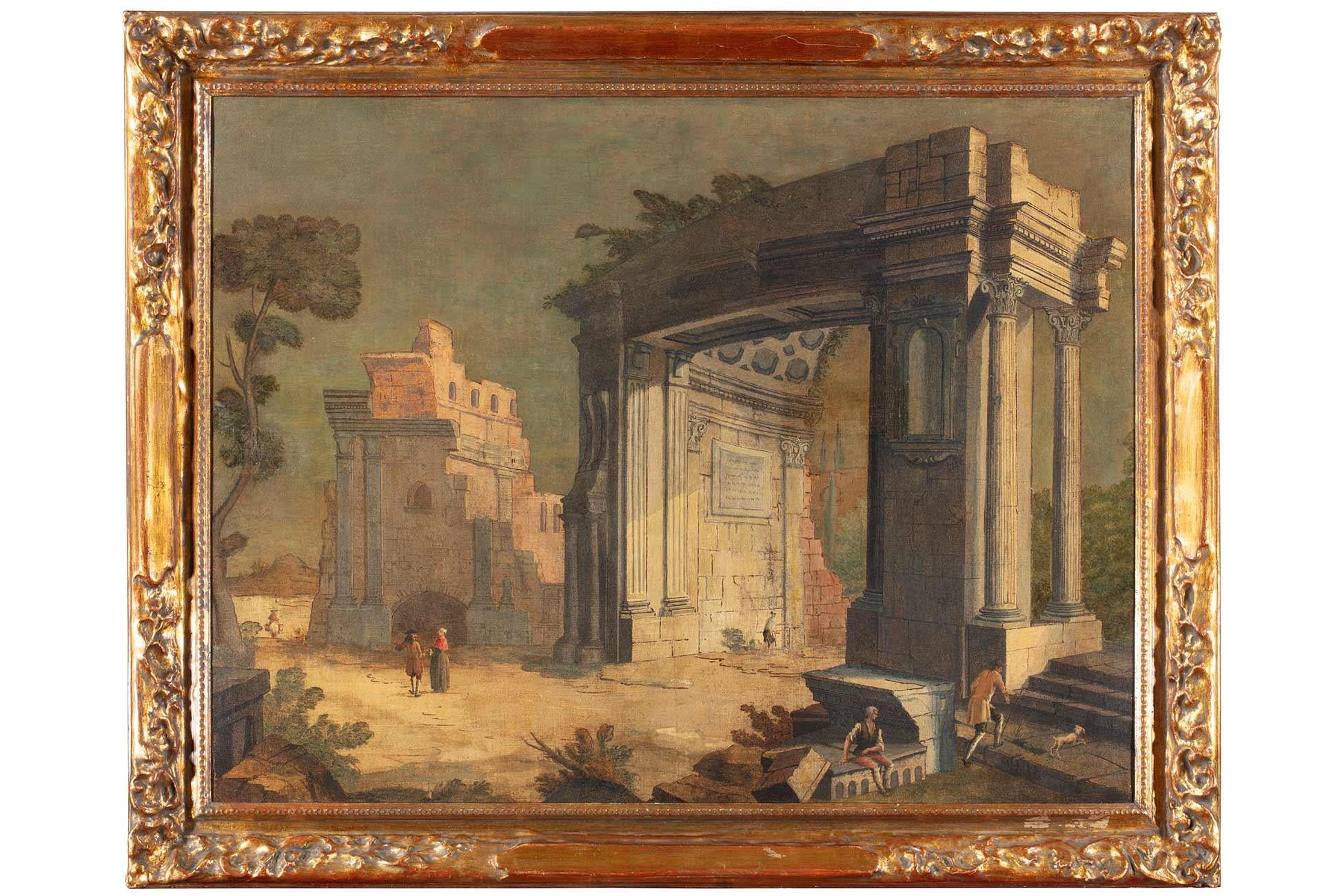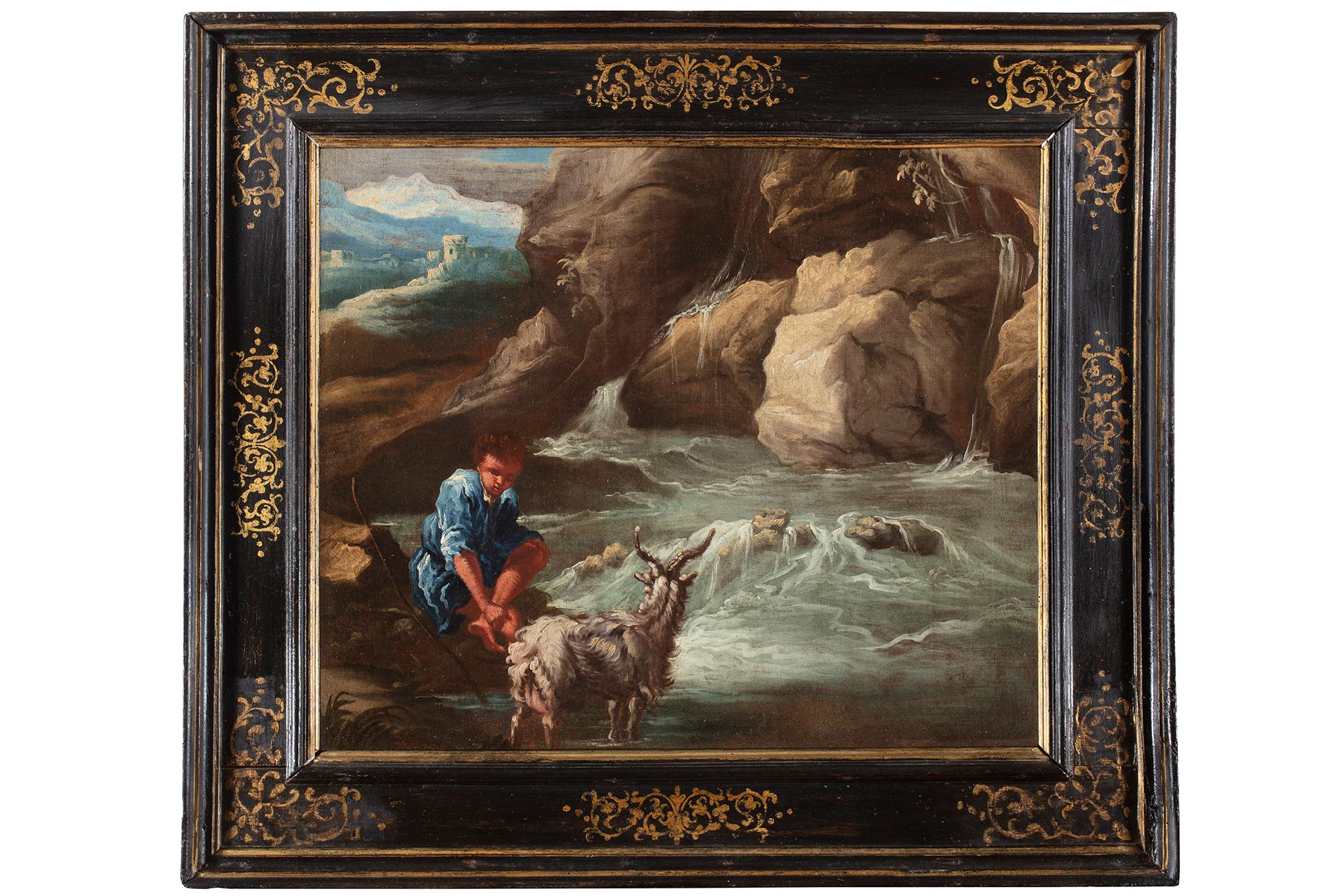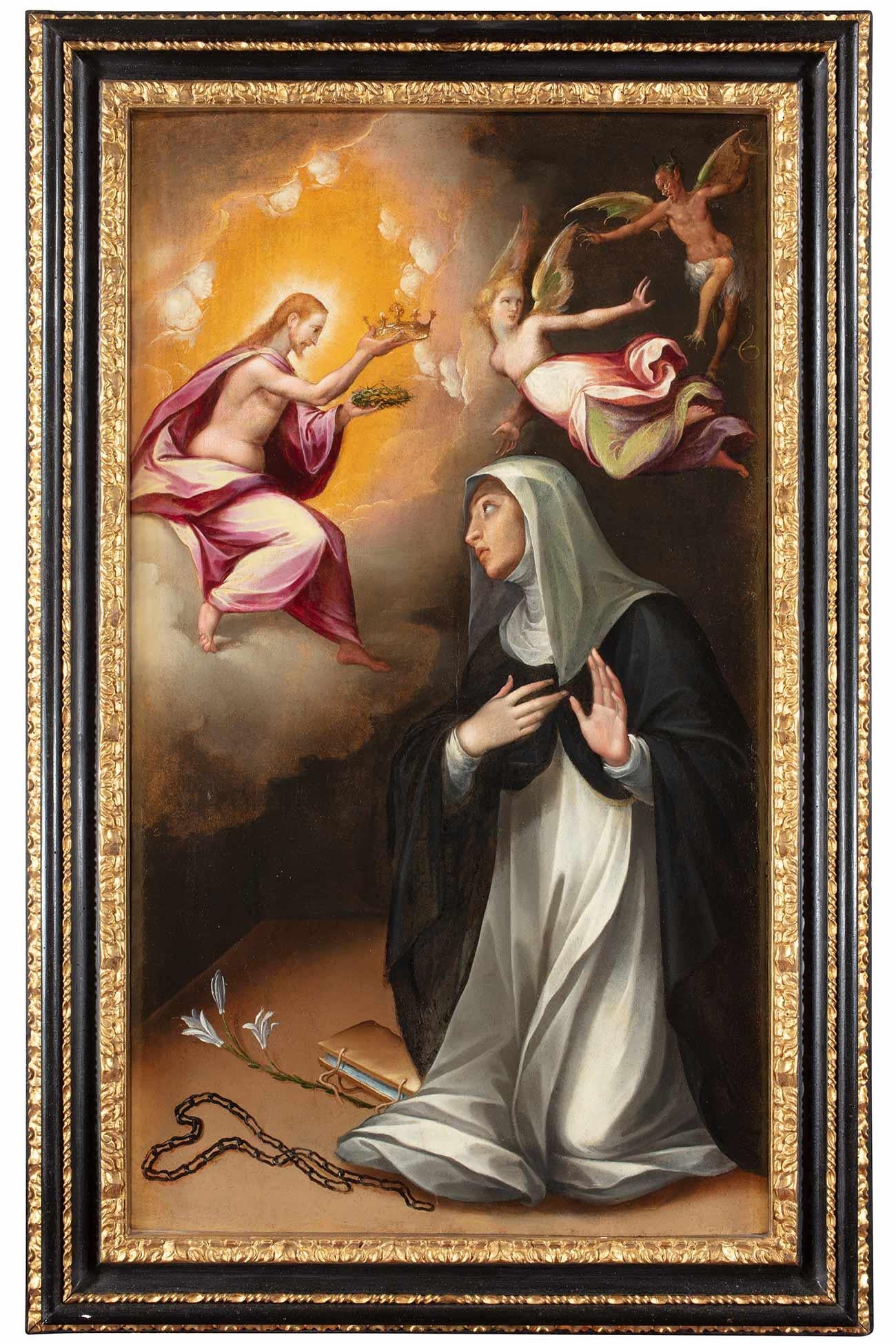Items Similar to Wooden Landscape with Shepherds, Fountain and Flock - by Jan Frans van Bloemen
Want more images or videos?
Request additional images or videos from the seller
1 of 9
Jan Frans van Bloemen (Orizzonte)Wooden Landscape with Shepherds, Fountain and Flock - by Jan Frans van Bloemen18th century
18th century
About the Item
Bibliography:
A.Busiri Vici, Jan Frans Van Bloemen Orizzonte e l’origine del paesaggio romano settecentesco, Ugo Bozzi Editore, Roma 1974, n.41
This artwork is shipped from Italy. Under existing legislation, any artwork in Italy created over 50 years ago by an artist who has died requires a licence for export regardless of the work’s market price. The shipping may require additional handling days to require the licence according to the final destination of the artwork.
- Creator:Jan Frans van Bloemen (Orizzonte) (1662-1749, Flemish)
- Creation Year:18th century
- Dimensions:Height: 18.9 in (48 cm)Width: 28.35 in (72 cm)Depth: 0.95 in (2.4 cm)
- Medium:
- Movement & Style:
- Period:
- Condition:Insurance may be requested by customers as additional service, contact us for more information.
- Gallery Location:Roma, IT
- Reference Number:
About the Seller
4.9
Platinum Seller
These expertly vetted sellers are 1stDibs' most experienced sellers and are rated highest by our customers.
1stDibs seller since 2017
6,739 sales on 1stDibs
Typical response time: 2 hours
- ShippingRetrieving quote...Ships From: Rome, Italy
- Return PolicyA return for this item may be initiated within 14 days of delivery.
More From This SellerView All
- The Knight - painting - XVII centuryLocated in Roma, ITThe Knight is an original oil painting on canvas realized during the XVII century by an anonymous artist. Provenance: Pecci-Blunt collection. Good condition...Category
17th Century Old Masters Figurative Paintings
MaterialsCanvas, Oil
- Martyrdom of Saint Stephen- Painting attr. to Vincent Adriaenssen- 17th CenturyLocated in Roma, ITLandscape with martyrdom of Saint Stephen is an old master artwork realized in 17th century. Mixed colored oil painting on canvas. Includes coeval gilded frame cm. 148x196. The artwork is attributed to Vincent Adriaenssen called il Manciola (Antwerp, 1595 - Roma, 1675) Among the painters who worked in the first half of the seventeenth century it is possible to indicate only the Neapolitan Scipione Compagno (1624-1680) as the author of scenes of martyrs set within a landscape or a view such as, for example, the Martyrdom of Saint Stefano recently hesitated at the Ansorena in Madrid on June 16, 2021. It should be noted, however, that the landscape represented in the painting examined here, characterized by luxuriant vegetation, meticulously represented "in the Flemish style", shows differences with the typical settings of the paintings di Compagno, characterized above all by urban views, visionary architectures or rather arid vegetation. Even the refined figures, so elongated and lanky, represented in our painting, in particular the group of knights in the foreground on the right, are not reflected in the production of the Neapolitan painter. These elements, to which we add the depiction of the Eternal Father amidst the clouds and the detail of the dog in profile in the foreground, instead recall a painter mainly known as a battle soldier, but who was also the author of many works depicting episodes from ancient Rome set within luxuriant landscapes, or rather Vincent Adriaenssen known as Manciola, a painter from Antwerp whose figure has been shed light thanks to recent studies. The group of horsemen represented to the right of the examined painting is, in fact, comparable with other groups on horseback present in numerous works by Manciola such as, for example, in the Triumph of Caesar (Rome, Babuino, 23-03-2010; formerly Florence, Collection Privata, 2006), while similar elongated and somewhat lanky figures, dressed in red, yellow, blue and white, can be found in the three paintings conserved at the Cassa di Risparmio di Pesaro, which in the past were erroneously attributed to the Umbrian painter Francesco Allegrini...Category
17th Century Old Masters Landscape Paintings
MaterialsOil
- Two Arcadic Landscapes - J.F. Van Bloemen (follower of) - Oil on CanvasBy Jan Frans van Bloemen (Orizzonte)Located in Roma, ITTwo Arcadic Landscapes are a couple of original oil paintings by a follower of the Flemish artist, Jan Frans Van Bloemen (1662-1749). These old master's original paintings represen...Category
Early 18th Century Old Masters Landscape Paintings
MaterialsOil
- The Return from Fishing - Oil Paint by Giovan Battista Filosa - 1908Located in Roma, ITThe Return from Fishing (Original Title: Il Ritorno dalla Pesca), is an original oil painting realized by Giovan Battista Filosa in 1908. Some fishermen seen from behind, in the blue light of the sky, with the vesuvius in the background, are the protagonists of the painting in "Il ritorno dalla pesca" by Giovan Battista Filosa (Castellamare di Stabia 1850 - Naples 1935) student of the famous Neapolitan painter...Category
Early 1900s Modern Landscape Paintings
MaterialsOil, Canvas
- Rock Tombs Outside Jerusalem - Oil Paint by Carl Schirm - 1884Located in Roma, ITCarl Schirm was a German painter of landscapes. Between 1880-1881 he made, together with Eugen Bracht, a long journey to Egypt, Palestine and Syria, at the end of which emerged lands...Category
1880s Modern Figurative Paintings
MaterialsOil, Canvas
- Mountain Mystery - Oil Paint by Elena Mardashova - 2023Located in Roma, ITOriginal oil painting on canvas 70X50 cm, entitled Mountain Mystery. Excellent condition.Category
2010s Contemporary Figurative Paintings
MaterialsCanvas, Oil
You May Also Like
- Early oil depicting the Great Fire of LondonLocated in London, GBThe Great Fire of London in September 1666 was one of the greatest disasters in the city’s history. The City, with its wooden houses crowded together in narrow streets, was a natural fire risk, and predictions that London would burn down became a shocking reality. The fire began in a bakery in Pudding Lane, an area near the Thames teeming with warehouses and shops full of flammable materials, such as timber, oil, coal, pitch and turpentine. Inevitably the fire spread rapidly from this area into the City. Our painting depicts the impact of the fire on those who were caught in it and creates a very dramatic impression of what the fire was like. Closer inspection reveals a scene of chaos and panic with people running out of the gates. It shows Cripplegate in the north of the City, with St Giles without Cripplegate to its left, in flames (on the site of the present day Barbican). The painting probably represents the fire on the night of Tuesday 4 September, when four-fifths of the City was burning at once, including St Paul's Cathedral. Old St Paul’s can be seen to the right of the canvas, the medieval church with its thick stone walls, was considered a place of safety, but the building was covered in wooden scaffolding as it was in the midst of being restored by the then little known architect, Christopher Wren and caught fire. Our painting seems to depict a specific moment on the Tuesday night when the lead on St Paul’s caught fire and, as the diarist John Evelyn described: ‘the stones of Paul’s flew like grenades, the melting lead running down the streets in a stream and the very pavements glowing with the firey redness, so as no horse, nor man, was able to tread on them.’ Although the loss of life was minimal, some accounts record only sixteen perished, the magnitude of the property loss was shocking – some four hundred and thirty acres, about eighty per cent of the City proper was destroyed, including over thirteen thousand houses, eighty-nine churches, and fifty-two Guild Halls. Thousands were homeless and financially ruined. The Great Fire, and the subsequent fire of 1676, which destroyed over six hundred houses south of the Thames, changed the appearance of London forever. The one constructive outcome of the Great Fire was that the plague, which had devastated the population of London since 1665, diminished greatly, due to the mass death of the plague-carrying rats in the blaze. The fire was widely reported in eyewitness accounts, newspapers, letters and diaries. Samuel Pepys recorded climbing the steeple of Barking Church from which he viewed the destroyed City: ‘the saddest sight of desolation that I ever saw.’ There was an official enquiry into the causes of the fire, petitions to the King and Lord Mayor to rebuild, new legislation and building Acts. Naturally, the fire became a dramatic and extremely popular subject for painters and engravers. A group of works relatively closely related to the present picture have been traditionally ascribed to Jan Griffier...Category
17th Century Old Masters Landscape Paintings
MaterialsOil, Canvas
- 18th Century By Vincenzo Re The Pool of Bethesda Oil on CanvasLocated in Milano, LombardiaExpertise by Prof. Giancarlo Sestieri. Vincenzo Re (Parma, 1695 – Napoli?, 1762) born in Parma, was an Italian scenic designer who during his career worked as initially an assistant...Category
18th Century Old Masters Landscape Paintings
MaterialsCanvas, Oil
- 17th Century by Simone Cantarini Adoration of The Magi Painting Oil on CanvasLocated in Milano, LombardiaSimone Cantarini (Pesaro 1612 - Verona 1648) Adoration of the Magi Oil on paper applied to canvas, cm. 16,5 x 24 – with frame cm. 22 x 29 Antique sh...Category
Early 17th Century Old Masters Figurative Paintings
MaterialsCanvas, Cotton Canvas, Oil
- 18th Century by Antonio Stom Architectural Capriccio Oil on Canvas_By Antonio StomLocated in Milano, LombardiaAntonio Stom (Venice c. 1688 - 1734) Architectural Capriccio oil on canvas, cm. 88 x 113 - with frame cm. 106 x 132 Carved, sculpted and gilded wooden frame Expertise: Giancarlo S...Category
Early 18th Century Old Masters Landscape Paintings
MaterialsCanvas, Cotton Canvas, Oil
- 18th Century by Giuseppe Pianca Shepherd with Goat and River Oil on CanvasLocated in Milano, LombardiaGiuseppe Antonio Pianca (Agnona di Borgosesia/VC, 1703 - after 1757) oil on canvas, cm. 49 x 57 - with frame cm. 67 x 77 Antique shaped wooden cassetta frame, ebony and gold decora...Category
18th Century Old Masters Landscape Paintings
MaterialsCanvas, Cotton Canvas, Oil
- 16th Century by Cristofano Roncalli Saint Catherine of Siena Oil on CanvasLocated in Milano, LombardiaCristofano Roncalli (Pomarance 1552 - Rome 1626) Saint Catherine of Siena chooses the crown of thorns oil on wood, cm. 101,5x59.5 - with frame cm. 120x76 Shaped, carved and sculpted wooden cassetta frame, partly gilded and partly ebonized wood Expertise: Marco Ciampolini The marvellous scene that opens before our eyes is that of Christ's apparition to Saint Catherine of Siena; she must choose between a golden crown, the symbol of earthly royalty, and a crown of thorns, the symbol of virtuous Christian sacrifice. Catherine does not hesitate to choose the crown of thorns, her life in imitation of...Category
16th Century Old Masters Landscape Paintings
MaterialsCanvas, Cotton Canvas, Oil
Recently Viewed
View AllMore Ways To Browse
Antique 50 Years
18th Century Italian Landscape
18th Century Landscape Italy
Antique Wooden Ship
Antique Wooden Ships
Old Fountain
18th Century Italian Landscape Painting
Ship Painting 18th Century
Shepherd And Flock
Shepherd With Flock
18th Century Oil Ship
E Romano
Jan Fran Bloemen
Jan Frans van Bloemen (Orizzonte) On Sale
Bottom Boat
Cowboy Artist Of America Art
Large Plein Air Oil Paintings
Norman French





